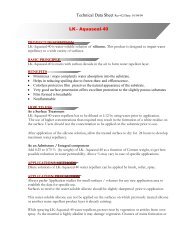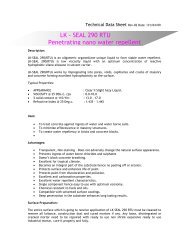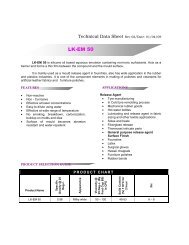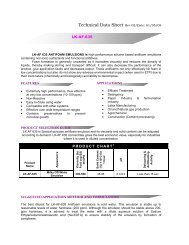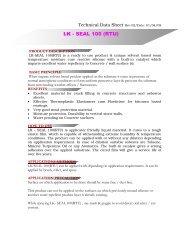View - ELKAY SILICONES
View - ELKAY SILICONES
View - ELKAY SILICONES
You also want an ePaper? Increase the reach of your titles
YUMPU automatically turns print PDFs into web optimized ePapers that Google loves.
Journal of Colloid and Interface Science 333 (2009) 635–640<br />
Contents lists available at ScienceDirect<br />
Journal of Colloid and Interface Science<br />
www.elsevier.com/locate/jcis<br />
Variation in emulsion stabilization behavior of hybrid silicone polymers with<br />
change in molecular structure: Phase diagram study<br />
Somil C. Mehta a ,P.Somasundaran a,∗ ,RaviKulkarni b<br />
a NSF Industry/University Cooperative Research Center for Advanced Studies in Novel Surfactants, Columbia University, New York, NY 10027, USA<br />
b Elkay Chemicals Pvt Ltd, Pune, India<br />
article info abstract<br />
Article history:<br />
Received 26 November 2008<br />
Accepted 12 January 2009<br />
Available online 18 January 2009<br />
Keywords:<br />
Silicone emulsion<br />
Phase diagram<br />
Hybrid silicone surfactants<br />
Silicone copolyol<br />
Ionic silicone<br />
Stability<br />
Silicone oils are widely used in cosmetics and personal care applications to improve softness and<br />
condition skin and hair. Being insoluble in water and most hydrocarbons, a common mode of delivering<br />
them is in the form of emulsions. Currently most applications use polyoxyethylene (non-ionic) modified<br />
siloxanes as emulsifiers to stabilize silicone oil emulsions. However, ionically grafted silicone polymers<br />
have not received much attention. Ionic silicones have significantly different properties than the nonionic<br />
counterpart. Thus considerable potential exists to formulate emulsions of silicones with different<br />
water/silicone oil ratios for novel applications. In order to understand the mechanisms underlying<br />
the effects of hydrophilic modifications on the ability of hybrid silicone polymers to stabilize various<br />
emulsions, this article focuses on the phase diagram studies for silicone emulsions.<br />
The emulsifying ability of functional silicones was seen to depend on a number of factors including<br />
hydrophilicity of the polymer, nature of the functional groups, the extent of modification, and the method<br />
of emulsification. It was observed that the region of stable emulsion in a phase diagram expanded<br />
with increase in shear rate. At a given shear rate, the region of stable emulsion and the nature of<br />
emulsion (water-in-oil or oil-in-water) was observed to depend on hydrophilic–hydrophobic balance of<br />
the hybrid silicone emulsifier. At a fixed amount of modification, the non-ionically modified silicone<br />
stabilized an oil-in-water emulsion, whereas the ionic silicones stabilized inverse water-in-oil emulsions.<br />
This was attributed to the greater hydrophilicity of the polyoxyethylene modified silicones than the ionic<br />
counterparts. In general, it is postulated that with progressive increase in hydrophilicity of hybrid silicone<br />
emulsifiers, their tendency to stabilize water-in-oil emulsion decreases with corresponding increase in<br />
oil-in-water emulsion. Further, this behavior is hypothesized to depend on the nature of modifying<br />
functional groups. Thus a hybrid silicone polymer can be tailored by selecting the nature and degree<br />
of hydrophilicity to obtain a desired silicone emulsion.<br />
© 2009 Elsevier Inc. All rights reserved.<br />
1. Introduction<br />
Silicone oils are used as emollients (skin softeners), lubricants,<br />
thickeners, and volatile liquids in many applications including textile<br />
treatment [1], personal [2] and home care [3], cosmetics [4],<br />
drug delivery [5] and printing ink formulations [6]. Mostofthese<br />
applications are water-based. Thus in order to make silicone oil<br />
compatible with water, hybrid silicone emulsifiers are used [7]. The<br />
choice of hybrid silicones is very important to achieve the most efficient<br />
formulation of emulsions of silicones with water [8].<br />
Silicone emulsions have historically been made using nonionically<br />
modified silicone emulsifiers, also known as silicone<br />
polyethers or silicone copolyols [7]. In most cases, the hydrophilic<br />
moiety of choice has been polyoxyethylene (EO) or polyoxypropy-<br />
*<br />
Corresponding author. Fax: +1 212 854 8362.<br />
E-mail address: ps24@columbia.edu (P. Somasundaran).<br />
lene (PO) [9,10]. They have been studied in some detail for their<br />
emulsifying properties to stabilize water/silicone oil [7,11–13] and<br />
hydrocarbon oil/silicone [14] emulsions. Microstructures of emulsions<br />
stabilized using non-ionic silicones have also be studied in<br />
past [15,16].<br />
In the case of ionic silicone surfactants, cationic [17,18] and<br />
anionic [19] trisiloxanes have been found to behave as excellent<br />
foaming agents [20,21]. There has been some work done on the<br />
solution properties of cationic [22], anionic [23] and zwitterionic<br />
[21] silicone surfactants. However, very little is known about the<br />
emulsifying properties of these ionic compounds. As opposed to<br />
non-ionic silicones, the area of liquid–liquid interfacial behavior<br />
of ionic silicones has remained mostly unexplored. Ionic silicones<br />
show very different properties than the non-ionic counterparts.<br />
Thus ionic silicones are expected to demonstrate completely different<br />
emulsion stabilization behavior, which might lead to the development<br />
of novel applications. Thus a comparative phase diagram<br />
study of hybrid silicones as a function of hydrophilic modification<br />
0021-9797/$ – see front matter © 2009 Elsevier Inc. All rights reserved.<br />
doi:10.1016/j.jcis.2009.01.028
636 S.C. Mehta et al. / Journal of Colloid and Interface Science 333 (2009) 635–640<br />
was continuously stirred under low shear or high shear. At low<br />
shear rate, the emulsification was achieved by imparting shear using<br />
a magnetic stir bar (L = 10 mm, φ = 4mm,1500rpm).High<br />
shear rate was achieved by homogenization using Ultraturrax T-18<br />
homogenizer at 22000 rpm. The emulsification was achieved by<br />
homogenizing for 2 min after the addition of water. The nature of<br />
emulsion (oil-in-water or water-in-oil) was determined by conductivity<br />
measurements. Emulsion stability was monitored by visual<br />
observation of oil or water separation. The emulsion was considered<br />
to be stable if there was no separation of oil or water after<br />
allowing it to stand under gravity for 24 h.<br />
2.2.2. Microscopy<br />
The oil–water interface was observed using a Nikon Eclipse microscope<br />
(Model ME 600) under transmitted light. Spot Insight CCD<br />
camera (Model #4.2) was utilized to capture images of emulsions<br />
to measure the dispersed phase droplet sizes [25].<br />
3. Results and discussion<br />
3.1. Nature of emulsion<br />
Fig. 1. Structural representation of functionally modified silicone polymer. The grafting<br />
ratio is denoted by m:n.<br />
is undertaken in the present work. It is intended to establish the<br />
effect of hydrophilic modifications on the ability of hybrid silicone<br />
polymer to stabilize silicone emulsions.<br />
2. Experimental<br />
2.1. Materials<br />
Various polymeric silicone surfactants with non-ionic, cationic,<br />
anionic and amphoteric functional modifications were synthesized<br />
at Elkay Chemical Pvt. Ltd. (Pune, India) and used for the current<br />
study without further purification. Amino modified polymeric silicone<br />
was synthesized from decamethyl cyclopentasiloxane (D5),<br />
tetramethyl ammonium hydroxide, and amino siloxane via the<br />
equilibration process. The cationic methylated amino silicone was<br />
synthesized by mono-methylation of the amino modified polymeric<br />
siloxane using p-tolyl methyl tosylate and the anionic silicone<br />
polymer by reacting the amino modified silicone polymer<br />
with itaconic acid [24], while the non-ionically modified silicones<br />
were synthesized by hydrosilation of silanic hydrogen moiety with<br />
poly(allyl alkoxylate). In addition, in some cases 50% of the amino<br />
groups in aminosilicone were modified to obtain 50% acid and<br />
methylated amino silicones. The ratio of the reactants was selected<br />
to give m:n ratio of approximately 1:7.5 (Fig. 1, where m = a + b).<br />
In a separate series, acid modified silicones with m:n ratio of<br />
1:4.5 and 1:99 were also synthesized. The approximate molecular<br />
weight of all the compounds as measured from viscosity was<br />
5000 and a volatile content below 1%. The details on the synthesis<br />
of each polymer has been reported earlier [23]. The general structures<br />
of the above mentioned silicone surfactants are illustrated in<br />
Fig. 1.<br />
Decamethyl cyclopentasiloxane was purchased from Aldrich Co.<br />
and used without any purification as silicone oil. Triple distilled<br />
water was used as the aqueous phase.<br />
2.2. Methods<br />
2.2.1. Emulsion preparation<br />
Emulsions were prepared by first dissolving the functionalized<br />
polymeric silicone surfactants in cyclic silicone oil followed by<br />
dropwise addition of water. No pH adjustment was made in water,<br />
and thus all the emulsions were prepared at pH ∼6. The mixture<br />
Unlike the non-ionic silicone surfactants, most of their ionic<br />
counterparts stabilized an inverse water-in-oil emulsion. The nonionic<br />
silicone surfactant has hydrophilic ethylene oxide chains (10<br />
EO units), which make them hydrophilic and water soluble. On<br />
the other hand, under identical percentage modification, the ionic<br />
silicone surfactants are relatively less hydrophilic due to shorter<br />
graft chains, and are more compatible with the cyclic silicone oil.<br />
Emulsions were prepared at pH 6, which leads to partial ionization<br />
of ionic functional groups. This also will play a role in making<br />
ionic silicone polymers less soluble in water than non-ionic silicone.<br />
Due to these properties, the emulsions formed with ionic<br />
silicone emulsifiers were water-in-oil emulsions. It is noteworthy<br />
that the inverse emulsion stabilized by one of the acid modified<br />
silicone co-polymer with low shear rate was stable up to as high<br />
as 80% of water as the inner phase. Due to very high concentration<br />
of dispersed water droplets these emulsion appeared very creamy.<br />
The more soluble non-ionic silicone surfactant formed an oilin-water<br />
emulsion. These emulsions could not reach as high a<br />
dispersed phase concentration as the emulsions stabilized by the<br />
ionics and therefore appeared like milk. The maximum amount of<br />
oil that could be stabilized as dispersed phase in water continuum<br />
with non-ionic silicones was about 20%.<br />
3.2. Phase diagrams<br />
Phase diagrams were measured under low and high shear in<br />
order to understand the effect of method of emulsification on the<br />
stabilization behavior of emulsions.<br />
3.2.1. Low shear rate<br />
Under low shear conditions, amino silicone and methylated<br />
amino silicone were unable to stabilize any emulsions. However,<br />
the acid modified silicone co-polymer was observed to give a stable<br />
emulsion in a very narrow region of 80% water and 20% oil<br />
at most emulsifier concentrations. The phase diagram for 1% acid<br />
modified silicone is presented in Fig. 2. Below 80% water an excess<br />
oil layer was observed at the top of the formulation and<br />
above 80% water, excess water drops were observed at the bottom.<br />
Such behavior could be better understood by correlating them with<br />
Winsor emulsions [26]. Below 80% water content, the emulsions<br />
behaved similar to Winsor I, and above 80% water the emulsions<br />
behaved like Winsor II.<br />
Droplet size of the dispersed phase of the emulsions changed<br />
with the change in emulsion formulation. Though the emulsions
S.C. Mehta et al. / Journal of Colloid and Interface Science 333 (2009) 635–640 637<br />
Fig. 2. Phase diagram of silicone oil–water emulsion stabilized by 1% acid modified silicone polymeric emulsifier at low shear rate. (") Stableemulsion,(2) emulsion+ excess<br />
water, (!) emulsion+ excess oil.<br />
were turbid and macro-sized in the entire concentration range of<br />
components, the size of water droplets (as observed under microscope)<br />
decreased with increase in the amount of emulsifier.<br />
Emulsion was stable for more than a day with as low as 0.2%<br />
emulsifier (80% water and 20% silicone oil) with the droplet size of<br />
dispersed phase at about 250 μm. There were several oil pools in<br />
the emulsions as observed in Fig. 2 due to inefficient mixing. With<br />
increase in emulsifier concentration, the droplet size decreased to<br />
about 35 μm at 10% emulsifier concentration.<br />
3.2.2. High shear rate<br />
The phase diagrams of emulsions stabilized with various functional<br />
silicone surfactants with 11.7% modification measured at<br />
high shear rates are presented in Fig. 3. Itshouldbenotedthat<br />
out of 11.7%, about 6% constituted amino group and rest 6% modification<br />
was various functional groups (e.g. acid modified polymer<br />
is a ter-polymer of PDMS, amino silicone and acid modified silicone).<br />
It can be seen that the shape and size of the stable phase<br />
region change with the nature of the functional group modification.<br />
Compared to the other functional modifications, the emulsion<br />
made with the acid modified silicone was relatively more stable<br />
and more viscous. This is reflected by the wider region of stable<br />
emulsion in the phase diagram for acid modification as compared<br />
to the others. The maximum amount of water that could be incorporated<br />
in this water-in-oil (W/O) emulsions was about 50%.<br />
Above 50%, though a stable emulsion could be obtained, the period<br />
of stability was less than 24 h. Emulsions were obtained even<br />
with as low as 0.2% surfactant concentration, but they remained<br />
stable for maximum of 4 h and hence were not considered stable<br />
for the phase diagram study.<br />
Amino silicones, though showed a comparable wide region of<br />
stable emulsion as acid modified silicones, the emulsions formed<br />
with it was observed to be relatively less stable than the emulsions<br />
of acid modified silicone ter-polymer. Most of the emulsions<br />
destabilized within a week, whereas some of the emulsions made<br />
with acid modified silicones were stable up to 3 months (the phase
638 S.C. Mehta et al. / Journal of Colloid and Interface Science 333 (2009) 635–640<br />
Fig. 3. Phase diagram of silicone oil–water emulsions stabilized by 11.7% functional silicone polymeric emulsifiers at high shear rate. (") Stable emulsion, (!) phase separation,<br />
( ) turbid solution, ( ) water-in-oil emulsion, ( ) oil-in-water emulsion.<br />
diagrams drawn here represent stability for 24 h and thus this behavior<br />
is not captured here).<br />
The emulsifying ability of methylated amino silicone terpolymer<br />
was found to be negligible and no region of stable emulsion<br />
was observed. This in part can also be due to bulky tosylate<br />
counter ion. Effect of counter ion on phase stability is not considered<br />
in the present work.<br />
On the other hand, the EO modified silicone is very hydrophilic,<br />
and therefore is more compatible with water rather than the oil. It<br />
stabilizes an oil-in-water emulsion, especially in the low oil content<br />
region. The emulsions formed were translucent with the particle<br />
size of the dispersed phase in miniemulsion range, i.e. about<br />
100 to 400 nm [27]. Slight haze in the emulsions indicated that<br />
the drop size has not reached the level of a microemulsion (less<br />
than 100 nm).<br />
Amino group is the least hydrophilic among the selected functionalities,<br />
leading to better solubility in silicone oil than others.<br />
But due to the relatively low polarity of amino groups, amino silicones<br />
do not have good surfactant properties. Consequently amino<br />
silicones stabilize emulsions but only for a relatively short time.<br />
On methylation, the nitrogen atom of amino silicone acquires a<br />
positive charge, because of which the hydrophilicity of the polymer<br />
increases and the polymer becomes less compatible with the<br />
silicone oil (hydrophilicity will also be affected by tosylate counter<br />
ion). Though this increase in the hydrophilicity should increase the<br />
compatibility with water; it was seen that 11.7% modification was<br />
not enough to make the methylated silicone water soluble. Consequently,<br />
the emulsifying capability of methylated amino silicone<br />
polymer ter-polymer was significantly low. The hydrophilicity of<br />
acid modified silicone ter-polymer is higher than that of the amino<br />
silicone, yet the degree of modification of the tested acid modified<br />
silicone, was such that it retained its solubility in the oil phase.<br />
Therefore, because of the presence of strong hydrophilic group,<br />
acid modified silicone possessed higher water stabilizing capacity<br />
than the amino silicone. The acid modified silicones are thus<br />
better emulsifiers than the amino and methylated amino silicone.<br />
The non-ionically modified silicone co-polymer is very hydrophilic<br />
at similar grafting ratio because of the presence of long ethylene<br />
oxide side chains. As a result, the non-ionic silicone is water soluble<br />
and oil incompatible, and stabilizes oil-in-water emulsion. In<br />
general, it can be stated that with increase in hydrophilicity, the<br />
tendency to stabilize water-in-oil emulsion decreases and the oilin-water<br />
emulsion increases.<br />
The above hypothesis was tested by constructing the phase diagrams<br />
of acid modified silicones with different degree of acid<br />
modifications. The phase diagrams of 1%, 11% and 18% acid modified<br />
silicone co-polymer emulsifiers are presented in Fig. 4. Again<br />
it can be seen that as the percentage acid modification is increased,<br />
the hydrophilicity of the emulsifier increases, making it<br />
less compatible with the silicone oil. As a result, increase in hydrophilicity<br />
of the acid modified silicone leads to shrinking and<br />
eventual disappearance of the stable emulsion region. Based on<br />
these observations, it is postulated that with progressive increase<br />
in hydrophilicity of hybrid silicone emulsifier, its tendency to stabilize<br />
water-in-oil emulsion decreases and oil-in-water emulsion<br />
increases. Further, this tendency to switch from water-in-oil emul-
S.C. Mehta et al. / Journal of Colloid and Interface Science 333 (2009) 635–640 639<br />
Fig. 4. Phase diagram of silicone oil–water emulsions stabilized by various % modification of acid functional silicone polymeric emulsifiers at high shear rate. (") Stable<br />
emulsion, (!) phase separation, (<br />
) turbid solution.<br />
sion stabilizer to oil-in-water emulsion stabilizer depends on the<br />
nature of modifying functional group. The given EO modified silicone<br />
(11.7% modification) stabilizes oil-in-water emulsion, whereas<br />
the acid modified silicone at 11.7% modification stabilizes water-inoil<br />
emulsion.<br />
When Figs. 2 and 4(a) are compared for the phase diagrams<br />
of 1% acid modified silicone co-polymer, it can be seen that the<br />
increased shear rate helps to broaden the stable emulsion region.<br />
This can be explained as due to better spreading of the emulsifying<br />
polymer into the oil–water interfaces with higher shear rate, which<br />
is consistent with the mechanism of emulsion stabilization [29].<br />
Another interesting observation can be made by comparing the<br />
phase diagram of 11% acid modified ter-polymer in Fig. 4(b) with<br />
the phase diagram of 11.7% acid modified co-polymer in Fig. 3(c).<br />
Though the % modifications are similar, the region of stable emulsion<br />
in Fig. 4(b) is much smaller than that for the region of stable<br />
emulsion in Fig. 3(c). This can be due to the presence of 50% amine<br />
groups in the 11.7% modified silicone of Fig. 3(c). The presence<br />
of amino groups changes the solubilization and consequently the<br />
emulsification properties of the emulsifier. There is also a possibility<br />
for weak non-bonding interactions among the acid and amine<br />
groups of the same (intramolecular) or different (intermolecular)<br />
polymer chains which will aid the formation and stabilization of<br />
emulsions.<br />
3.3. Stability of emulsions<br />
Stability of emulsions is an important parameter that is indicative<br />
of the mechanism of emulsion stabilization. The stability of<br />
emulsions can be monitored by measuring the time required for<br />
separation of the two phases. Since it will take a long time for sep-<br />
Table 1<br />
Time required for phase separation of an emulsion made with 1% emulsifier, 70%<br />
water and 30% cyclic silicone oil.<br />
Compounds % modification X-component<br />
of 3D-HLB<br />
PDMS 0 0 0<br />
Amino silicone 11.70% 0.46 9<br />
Acid modified silicone 5.8% + 5.8% amino 1.91 55<br />
Methylated amino silicone 5.8% + 5.8% amino 2.76 0<br />
1% acid modified silicone 1% 0.44 9<br />
Time<br />
(min)<br />
aration of the two phases of a stable emulsion under free settling<br />
conditions, a method commonly used in the industry to assess the<br />
stability of emulsions is by monitoring the phase separation under<br />
centrifugation. Emulsions with 70% water, 30% oil and 1% emulsifier<br />
were made with emulsifiers as indicated in Fig. 3 and were<br />
discretely centrifuged at 1000 rpm for increasing durations until<br />
phase separation was observed. The times required for phase separation<br />
of various emulsions are presented in Table 1.<br />
In order to efficiently formulate an emulsion, it is useful to understand<br />
dependence of emulsion stability on the emulsifier structure.<br />
Toward this purpose, an attempt was made to correlate the<br />
time required for emulsion destabilization with the 3D-HLB concept<br />
[28]. 3D-HLB concept is based on the representation of emulsion<br />
type on a ternary diagram made up of hydrophilic, lipophilic<br />
and silophilic moieties of the molecule represented by 3 coordinates.<br />
In the selected emulsifiers, there is a regular variation in the<br />
functional group (or hydrophilicity) with the remaining molecule<br />
maintained constant. Since only the functional group is changing,<br />
the X-component of 3D HLB, which represents the hydrophilicity<br />
of the silicone emulsifier, was correlated with the emulsifier per-
640 S.C. Mehta et al. / Journal of Colloid and Interface Science 333 (2009) 635–640<br />
emulsion stabilities quantitatively, the stability of emulsions was<br />
correlated with the structure of the emulsifier using the 3D-HLB<br />
concept. It was observed that the emulsion stability at a centrifugation<br />
speed of 1000 rpm (∼100g) follow a linear profile<br />
with the hydrophilic component of 3D-HLB concept, but the correlation<br />
brakes at higher hydrophilicity when the phase inverses<br />
from water-in-oil to oil-in-water. The observed phenomenon can<br />
be used to predict and adapt the emulsion stabilization performance<br />
of hybrid silicone by selecting the nature and degree of<br />
hydrophilic modification.<br />
Acknowledgments<br />
Fig. 5. Correlation between the stability of emulsions under centrifugation at<br />
1000 rpm with the X-component of 3D HLB.<br />
formance. Fig. 5 shows a plot of the stability of the emulsions as a<br />
function of the hydrophilicity of the silicone emulsifier. A linear relation<br />
can be observed between the stability of emulsions and the<br />
hydrophilicity of the emulsifier. However the trend breaks when<br />
the emulsifier becomes incompatible with the cyclic silicone oil.<br />
Thus, it is clear, that the ability to stabilize water-in-oil and oil-inwater<br />
emulsion can be tailored by adjusting the hydrophilicity of<br />
the hybrid silicone polymers. This behavior, except for the phase<br />
inversion behavior, can be predicted with 3D-HLB model.<br />
4. Summary<br />
In order to effectively formulate silicones oil/water emulsions,<br />
it is vital to have an accurate knowledge of the mechanisms by<br />
which modified silicone polymeric emulsifiers act and their required<br />
properties. Phase diagrams studies of silicone oil and water<br />
were undertaken in this work to understand the effect of functional<br />
modifications on the emulsifying ability of hybrid silicone<br />
polymers. It was observed that the emulsion stability was dependent<br />
on the functional modification as well as method of emulsification.<br />
Under low shear rate conditions, the tested acid modified<br />
silicone co-polymer stabilized an inverse water-in-silicone oil<br />
emulsioninaverynarrowwindowofaround80%waterand20%<br />
oil. The aminosilicone and quaternary amino silicone co-polymers<br />
were unable to stabilize the emulsion. With increase in shear rate,<br />
the region of stable emulsion expanded. The amino and acid modified<br />
silicone ter-polymer stabilized inverse emulsions, whereas the<br />
quaternary amino silicone ter-polymer was unable to stabilize an<br />
emulsion under tested conditions. Conversely, the tested EO modified<br />
silicone stabilized an oil-in-water emulsion with up to 20%<br />
water as the dispersed phase. The observed behavior of emulsion<br />
stabilization is explained based on the hydrophilic–hydrophobic<br />
balance of the hybrid silicone polymers. It is postulated that with<br />
increase in hydrophilicity of hybrid silicones, its tendency to stabilize<br />
water-in-oil emulsion decreases and oil-in-water emulsion<br />
increases. Further, this tendency for switching from water-in-oil<br />
emulsifier to oil-in-water emulsifier depends on the nature and<br />
extent of functional modification. In order to be able to predict<br />
Theauthorswouldliketoacknowledgethesupportfromthe<br />
National Science Foundation (Grant #0328614) and industry sponsors<br />
of the Industry/University Center for Novel Surfactants at<br />
Columbia University.<br />
References<br />
[1] P. Bajaj, J. Appl. Polym. Sci. 83 (3) (2000) 631–659.<br />
[2] M.S. Starch, US patent 4,311,695 (1982).<br />
[3] R.M. Hill, Silicone (Siloxane) Surfactants, vol. 14, 3rd ed., Academic Press, San<br />
Diego, CA, 2002, p. 793.<br />
[4] J. Newton, C. Stoller, M. Starch, Cosmet. Toiletries 119 (5) (2004) 69–70, 72–74<br />
76, 78.<br />
[5] M. Kajihara, T. Sugie, H. Maeda, A. Sano, K. Fujioka, Y. Urabe, M. Tanihara, Y.<br />
Imanishi, Chem. Pharm. Bull. 51 (1) (2003) 15–19.<br />
[6] M. Rentzhog, A. Fogden, Prog. Org. Coat. 57 (3) (2006) 183–194.<br />
[7] R.M. Hill, Silicone Surfactants, Surfactant Science Series, Marcel Dekker, 1999.<br />
[8] A.J. O’Lenick, J. Surfact. Deterg. 3 (3) (2000) 387–393.<br />
[9] K.P. Ananthapadmanabhan, E.D. Goddarnd, P. Chandar, Colloids Surf. 44 (1990)<br />
281–297.<br />
[10] Y. Sela, S. Magdassi, N. Garti, J. Controlled Release 33 (1995) 1–12.<br />
[11] J. Sjoblom, Encyclopedic Handbook of Emulsion Technology, Marcel Dekker,<br />
2001.<br />
[12] J. Brandrup, E.H. Immergut, Polymer Handbook, 3rd ed., Wiley, New York, 1989.<br />
[13] S.S. Soni, N.V. Sastry, J. George, J. Phys. Chem. B 107 (2003) 5382–5390.<br />
[14] O. Suitthimeathegorn, V. Jaitely, A.T. Florence, Int. J. Pharm. 298 (2005) 367–<br />
371.<br />
[15] X. Li, R.M. Washenberger, L.E. Scriven, H.T. Davis, R.M. Hill, Langmuir 15 (7)<br />
(1999) 2267–2277.<br />
[16] X. Li, R.M. Washenberger, L.E. Scriven, H.T. Davis, R.M. Hill, Langmuir 15 (7)<br />
(1999) 2278–2289.<br />
[17] W.G. Reid, US patent 3,389,160 (1968).<br />
[18] W.G. Reid, US patent 3,836,559 (1974).<br />
[19] (a) B. Kanner, R.A. Pike, E.L. Morehouse, US patent 3,507,897 (1970);<br />
(b) B. Kanner, R.A. Pike, E.L. Morehouse, US patent 3,531,417 (1970).<br />
[20] M.R. Rosen, B. Prokai, US patent 3,677,347 (1972).<br />
[21] S.A. Snow, W.N. Fenton, M.J. Owen, Langmuir 7 (1991) 868–871.<br />
[22] G. Schmaucks, G. Sonnek, R. Wustneck, M. Herbst, R. Ramm, Langmuir 8 (1992)<br />
1724–1730.<br />
[23] S.C. Mehta, P. Somasundaran, C. Maldarelli, R. Kulkarni, Langmuir 22 (23)<br />
(2006) 9566–9571.<br />
[24] A. Berger, D.L. Fost, US patent 5,596,061 (1997).<br />
[25] J.W. Anseth, A. Bialek, R.M. Hill, G.G. Fuller, Langmuir 19 (2003) 6349–6356.<br />
[26] P. Winsor, Solvent Properties of Amphiphilic Compounds, Butterworth, London,<br />
1954.<br />
[27] P. Somasundaran, T.H. Wines, S.C. Mehta, N. Garti, R. Farinato, Surfactants in<br />
Personal Care Products and Decorative Cosmetics, 3rd ed., Surfactant Science<br />
Series, vol. 135, 2007, pp. 149–175.<br />
[28] A.J. O’Lenick Jr., J.K. Parkinson, Cosmet. Toiletries 111 (10) (1996) 37–38, 41–44.<br />
[29] S.C. Mehta, P. Somasundaran, Langmuir 24 (9) (2008) 4558–4563.


